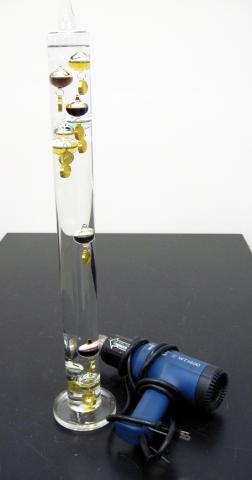Galileo's Thermometer
Galileo (1564-1642) first discovered that the density of a fluid is linked to temperature. Through a series of experiments, Galileo learned that a fluid’s density increases as temperature drops, but decreases as it warms up. To demonstrate his theory, Galileo placed several liquid-filled glass spheres into a water tank to observe their reaction to temperature changes. As he predicted, a solid body of known weight will rise or fall with fluctuations in temperature.
Each of the eleven temperature balls within this thermometer are exactly weighed and fitted with a metal Fahrenheit temperature medallion. The thermometer measures from 62° to 82° F in steps of 2°.
Simply look at the lowest floating temperature ball within the group of balls floating at the top of the thermometer to tell the correct temperature—68° in this measurement to the left.
You will find that the balls will slowly fall as the temperature rises, and rise up again when the temperature cools.
Required Equipment

